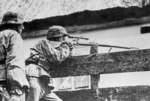Gewehr 98 Rifle
| Country of Origin | Germany |
| Type | Rifle |
| Caliber | 8.000 mm |
| Capacity | 5 rounds |
| Length | 1.250 m |
| Barrel Length | 740.000 mm |
| Weight | 4.090 kg |
| Rate of Fire | 30 rounds/min |
| Range | 500.000 m |
| Muzzle Velocity | 878 m/s |
Contributor: C. Peter Chen
ww2dbaseGewehr 98 bolt-action rifles were adopted by the German Army as the standard infantry rifles in 1898, but the first major issue of the weapon did not take place until 1901. They first saw action during the Boxer Rebellion in China in 1901. In 1904, Waffenfabrik Mauser received a contract to build 290,000 rifles and Deutsche Waffen und Munitionsfabriken received a contract for 210,000. In 1908, the Karabiner 98az variant design entered production, which had shorter barrels for cavalry units and support units; they represented an upgrade of the Karabiner 98a variants produced since 1898 but had not been considered successful. In the spring of 1915, 15,000 select examples were ordered to be equipped with telescopic sights, converting them into sniper rifles; when the conversion work was done, 18,421 examples were built. Gewehr 98 rifles of different variants saw extensive combat in WW1, not only with the Germans but also with troops of the Ottoman Empire. In 1923, the Karabiner 98b variant was introduced largely for the reason of producing a weapon that complied with the Treaty of Versailles limitations. These rifles remained the main service rifle of the German Army until 1935, when they were replaced by the Karabiner 98k rifles, whose design was based on the Gewehr 98. A total of about 5,000,000 Gewehr 98 rifles were built in Germany.Starting in Aug 1935, the Chinese purchased the Gewehr 98 blueprint, made modifications to shorten (to 1,110 millimeters overall) and lighten (to 4.08 kilograms) to the design, and began producing them locally at Kunghsien, Hanyang, Jinglin and Guangdong Arsenals under the designation Type 24. These rifles were later renamed Zhongzheng Type 24 rifles; as Zhongzheng was Chinese leader Chiang Kaishek's proper name commonly used in China but rarely referred to by Westerners, Westerners coined their own name for these weapons, "Chiang Kaishek rifles" or "CKS rifles".
In 1936, sporting rifles were made based on the Gewehr 98 and were sold to the civilian market.
During the Spanish Civil War, a number of Gewehr 98 rifles were used by the Spanish Nationalist forces and German volunteer units.
During WW2 in China, Zhongzheng Type rifles armed the bulk of the non-German trained Chinese Army units (while the German-trained Chinese Army units, fewer in number, were usually armed with imported Karabiner 98k rifles). Somewhere between 500,000 and 600,000 Zhongzheng Type rifles were built in China between 1935 and 1945, seeing extensive combat in China and Burma. Several thousand more examples were built between 1945 and 1949.
During the final days of the European War, many Gewehr 98 rifles were taken out of warehouses and assigned to Volkssturm forces for the final defense of Germany. Production of Gewehr 98 rifles ceased in Germany with the surrender in 1945.
During the Chinese civil war that resumed shortly after the end of WW2, both Nationalist and Communist forces wielded Zhongzheng rifles against the other. After the civil war, in the 1950s, the Nationalist military, now based in Taiwan, slowly phased out these rifles in favor of American-supplied rifles such as the M1 Garand and the M1 Carbine. Chinese Communists used these weapons during the Korean War; some remained service rifles with police forces until the 1980s while a few are still in service as ceremonial rifles at the time of this writing in 2011.
In the 1960s, many of the Gewehr 98 rifles in Spain were bought as military surplus by the International Armament Corporation (Interarmco) and imported into the United States for civilian sporting use.
In 1999, Mauser Jagdwaffen GmbH resumed production of the Gewehr 98 design for civilian use. These rifles were built based on the 1936 sporting rifle design.
Source: Wikipedia ww2dbase
Last Major Revision: May 2011
Gewehr 98 Rifle Interactive Map
Photographs
 |  |  |  |
Gewehr 98 Timeline
| 8 Apr 1898 | Gewehr 98 rifles were named the standard infantry rifles of the German Army. |
| 9 Sep 1898 | Paul Mauser patented the bolt-action design he would later use for the Gewehr 98 rifles. |
Please consider supporting us on Patreon. Even $1 per month will go a long way! Thank you. Please help us spread the word: Stay updated with WW2DB: |
Search WW2DB
News
- » US Women's Army Corps "Six Triple Eight" Awarded with Congressional Gold Medal (30 Apr 2025)
- » Wreck of Soviet Submarine M-49 Found (10 Apr 2025)
- » Japanese Emperor Visited Iwoto (Iwo Jima) (8 Apr 2025)
- » Race, Holocaust, and African-American WW2 Histories Removed from the US Naval Academy Library (7 Apr 2025)
- » US Government Plans to Purge WW2 Information (17 Mar 2025)
- » See all news
Current Site Statistics
- » 1,167 biographies
- » 337 events
- » 44,615 timeline entries
- » 1,244 ships
- » 350 aircraft models
- » 207 vehicle models
- » 376 weapon models
- » 123 historical documents
- » 261 facilities
- » 470 book reviews
- » 28,518 photos
- » 365 maps
Famous WW2 Quote
"We no longer demand anything, we want war."Joachim von Ribbentrop, German Foreign Minister, Aug 1939
Support Us
Please consider supporting us on Patreon. Even $1 a month will go a long way. Thank you!
Or, please support us by purchasing some WW2DB merchandise at TeeSpring, Thank you!